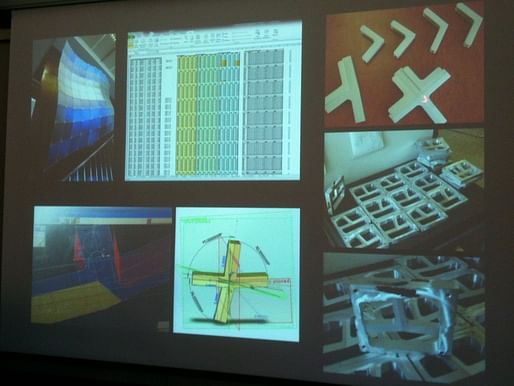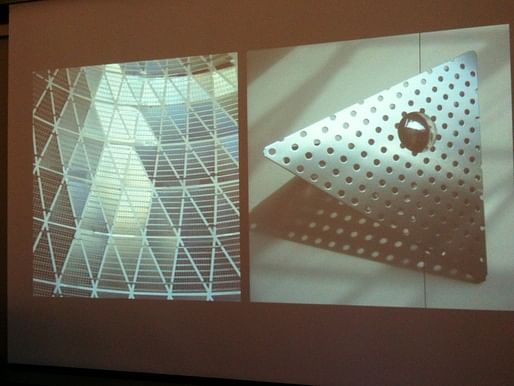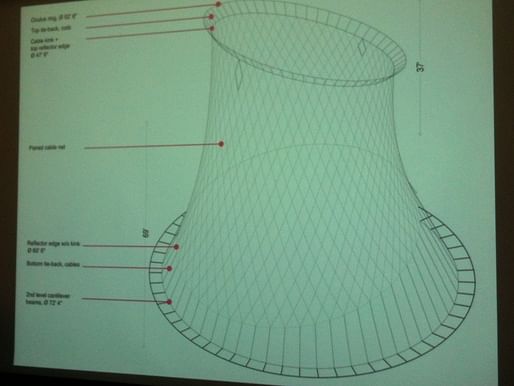
Hi Archinect,
I'm in Stubbins (a small room at the GSD) for James Carpenter and Michael Mulhern, a founding partner at TriPyramid Structures. Martin Bechthold made the introductions.

JC: "Michael just informed me that we've completed over 60 projects together."
MM: We build widgets, at the end of the day. Not systems--curtain walls or anything--but purpose-built parts to solve specific problems. Often for architecture or also for [yachts and other industries]. It's a high level of engineering and fabrication: in 1996, someone would take $25k, roughly, to take a pound out of the top of a sailboat mast. But you'd lose that premium if the mast fell off, into the water. So we were working with those kinds of premiums, and when we moved to architecture, you dial it back a little, but at the same time remember those roots.

Projects like the glass cube at Apple, in New York, where there's almost no hardware, are difficult--which is where the teamwork comes in. People come to us and say "how do I make it?" We do our best projects in this green zone, where everyone around the triangle is talking to each other and respecting each others' problems. I can't stress how important that is; if we're not listening to each other, everyone's expertise can't get used.

JC: This was an early glass stair, around 1992, ten years before the Apple stairs. We were exploring heavy laminated glass for the support structures. MM: The net structure was welded from the inside, so that the construction is barely evident. We used VHP tape, from 3M; [it was the first use of that material for this kind of application]. JC: We typically have our own crew for the installation. MM: One last point: when the architect or owner has an idea of the design, there comes a point when the exact geometry becomes relevant so that we can make it. One thing that characterizes how we work is that someone owns the model--not sort of owns it, but owns it, for example, to 1/64". Earlier, James Carpenter would own and control the model, and at some point that shifts over to us. It's a critical part of the process, who owns the geometry when, given the tight tolerances.
 JC: When we were starting, there weren't contractors who could do this kind of thing for you. The skill sets weren't out there. There now are people who have those skill sets and who could oversee the whole process.
JC: When we were starting, there weren't contractors who could do this kind of thing for you. The skill sets weren't out there. There now are people who have those skill sets and who could oversee the whole process.



Schubert Club Band Shell. MM: The two arcs (perpendicular to each other, as in blue) are generally offset by a few inches. When that happens, you would then use diagonal bracing, using clamped cables (as in yellow). The structural engineer had to be convinced that there was a different way. He was a very, very good structural engineer, and held his conviction until we had tested this and shown him that we could create a single surface of rods, with a cleaner connection, instead of the multiple layers. [The joint] is exactly what we'd do for big sailboats. The end result worked out well, but it didn't happen overnight--it was a 2 or 3 month process. And that's typical, it takes time for us all to think through this.




MM: I'm not a concrete guy--not my specialty--but there are a few moments when I think, how on earth do they do that? These guys were able to cast this within 1/16", in the places where we needed it. For this, if there was a 1" gap between the concrete and metal, there'd be no way to hide it--and it was perfect. This is something I could do today, but not in the 90s as I didn't have the tools then.

MM: There was no adjustment in the length of any of this stuff, so we had to pre-build it. That's something we can generally do for art projects [not most architecture projects]. The other thing that happens is that when you get the thing out in the sunshine and look at it, it looks totally different. So there were all kinds of aesthetic things that got attacked [by pre-building].
MM: We joke about this; we don't get invited to a lot of opening parties and job sites. The only time we go is when there's a problem on site, and we don't want that.


Lens Ceiling, Federal Building and Courthouse, Phoenix, Arizona. 2000. JC: This was a project with Richard Meier. The environment around the drum is naturally cooled, using ventilation and a misting system. We took our inspiration from the idea of a frozen bubble (at left, below). In the diagram of the structure (at right) there are two rings, with two sets of cables to perpendicularly control the tension and the core of the roof. If you just drape the cables, you obviously get a catenary not a hemispherical shape, so we wanted to control the shape.

MM: The sprinkler pipes are part of the primary structure--the pipes come down and transfer to the hemisphere...they had to be the exactly correct length, because if they're not, then when you install the glass, you'd get to the end and the last pieces wouldn't fit. So, as we typically do, we had to tell the installers that they could not adjust anything.

Don't get any ideas here; this will likely be the only building in the world that has the sprinkler system as part of the primary structure. This building was for the federal government so they were able to [sidestep the regulations].

JC: The weights in this model represent the pre-loading of the system; we had barrels of water that pre-loaded the structure, which we removed as we connected the system.
JC:...This was a bit of a test case for the Apple projects.
MM: This material, SGP, laminating the glass together, makes it stiff enough so that the two pieces of glass act as one. Typically if you load the center of the glass, they act as two pieces of the glass. As Jamie says, this is how a lot of the Apple work gets done. The other thing that we did is that the SGP is the safety feature; you don't want glass falling down on federal judges' heads. So the corner of the glass is nipped off and the interlayer piece sticks out, with the bolt going through the interlayer. If there's a hole in the glass, the hole has to be far from the corner. JC: It's always further in than you'd like.
JC: The ceiling in appearance is quite light; you can stand at the edges and look up to the sky. You can predict the angle at which the light will refract through the glass, so we moved the lights up so that the light would be focused where the judges sit.

Luminous Grid Shell, Bank of America, Charlotte, NC 2005. JC: Sometimes we take a job just to test something. The end result of that project might not be [the most important thing about the project]. MM: This was a really difficult geometry. It requires gravity to settle into this shape, and it's very flexible and soft before then. That's nervous for the installers and everyone, until it assumes the shape. This is a very delicate piece; the ring that holds the rods and that is turned to tension the rods, is 1/2" in diameter. So the installer has a 1/2" long wrench with tiny holes to tension the rods.

 MM: [Explaining safety tests, breaking the glass to test its limits and failure conditions.] When you break a piece of tempered glass, it grows, because there's displacement at each of the cracks. When that happens, you're adding tension to the rods. This glass had no inclination to leave the structure after it was broken; we had to drive a forklift through it to get the glass out.
MM: [Explaining safety tests, breaking the glass to test its limits and failure conditions.] When you break a piece of tempered glass, it grows, because there's displacement at each of the cracks. When that happens, you're adding tension to the rods. This glass had no inclination to leave the structure after it was broken; we had to drive a forklift through it to get the glass out.


JC: You can now selectively pre-program a sheet of glass when you chemically strengthen it, so that when you release it, the glass automatically takes the shape you want, in one solid surface. So the technology is changing quickly in terms of strengthening and forming material.
JC: Hoboken Pier Handrails. This project used a woven stainless steel cylinder. ...MM: As hard as it is to believe, there was a big budget problem here. This handrail system wraps around, changes angles, and handles the wiring for the lighting. We didn't have a budget for casting multiple pieces, so a single articulating piece had to do it all.



Fulton Street Transit Center Dome, New York, NY, 2004-14. JC: It is quite a simple structure above ground. These are drawings from the competition; there's a pedway that cuts through, and the dome. Sometimes projects go on for a long time. It started in 2004, and the original conception was a dome on the roof that would bring the light in and, through primary and secondary reflections, bring it in to the building. In the value engineering phase we had to keep the idea of bringing light in this way but rethink how to achieve that.



MM: It's a design consideration when you're expecting something to sit there for 30 years. When there are temperature and humidity changes; are those specular materials going to dull? The piece isn't going to work if the pieces become dull. So we had accelerated environmental testing [to test the finish].


JC: Cameron [Wu] was working with me on the geometry. MM: To give kudos to Cameron, this is difficult. The geometry isn't regular and there's no "unfold" command in Rhino for this; it has to be solved mathematically.



MM: Public projects are difficult. When there are elections and other changes, everything can change, and the client's goal isn't necessarily the best possible building.

MM: This is a hand-holding mockup (above). For a project like this we can't do a technical mockup that tests the geometry; it was more about the materiality, the aesthetics, and the client's confidence that we could do it. And the mockup was a tremendous success in that regard, even though that's not the reason for the mockup as written in the contract.
JC: And the timing on these projects can be unforeseen. We designed it, and then ten years later, it's going to be installed. It does create some issues, but this one benefited from the value engineering phase.
End of presentation. Questions. I ask about the impact of these collaborations on the firms' internal organizations and means of delivering projects.
JC: We use a diagram similar to the one MM showed at the beginning: for our studio there's a combination of structural engineering, architecture, and art. So we look at the people working in our studios to have the facility to cross between those disciplines. As a studio, we're interested in light and materials. So a lot of people are invested in that, and we also have people in calculations and modeling. But our studio is quite different. To build many of these things 30 years ago, there was not an industry to turn to, to build these things. So it meant building capacity in house. And finding like-minded people, like Tripyramid who were interested and had the skills. We do less of the delivery ourselves now because our projects are bigger, but we try to maintain ownership of the design all the way through where it matters. We can't go through a conventional bidding process. It's a matter of how you hold on to control of parts of the building that you want to control, while knowing that it increases your liability to do that.
MM: Jamie's being modest. Some of the people in his studio are quite modest when it comes to how brilliant they are working with details, and it's always immediately apparent in working with his studio versus other clients of ours. From the point of view of our firm, the same thing is happening but from the bottom up. From our point of view, when we started, our thought was selling simply tie rods and widgets to architectural firms. As Jamie mentioned, control is a main issue: we are 12 architects and engineers; whereas in a normal fabrication firm of our size you'd have one engineer drawing details. We have to develop full system drawings for complicated projects even if we're not making the glass, in order for it to work. So there's that level of it, and the communication.
MM: And I'll say that architects talk to architects better than architects talk to engineers. So we have architects at the front end who liaise, who do that better at that than me, as an engineer by training. So we've come from the bottom and Jamie's has come from the top; our firms overlap a lot. Which is almost commercially unfortunate. When we started we needed each other a ton. We need each other less now, we still collaborate because results still come out better.
Question: What is the role of glass in this? Is it custom?
JC: Again, that's something that differentiates our studio, for better or worse. All of that interest in glass, technically, and our interest in materials. There are other a variety of relationships with primary and secondary industries--the primary industries being the companies that do the float (glass production) itself, and the secondary industries that do coatings and other treatments. So you find where you can innovate.
End. Applause.
Thanks for reading!
Lian
This blog was most active from 2009-2013. Writing about my experiences and life at Harvard GSD started out as a way for me to process my experiences as an M.Arch.I student, and evolved into a record of the intellectual and cultural life of the Cambridge architecture (and to a lesser extent, design/technology) community, through live-blogs. These days, I work as a data storyteller (and blogger at Littldata.com) in San Francisco, and still post here once in a while.



No Comments
Block this user
Are you sure you want to block this user and hide all related comments throughout the site?
Archinect
This is your first comment on Archinect. Your comment will be visible once approved.